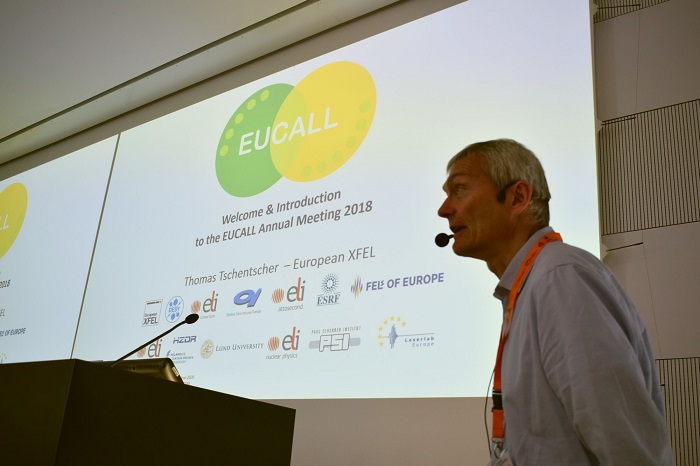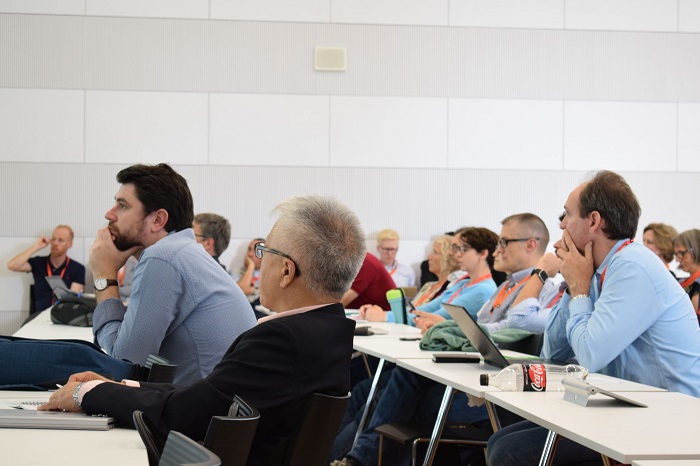EUCALL holds final Annual Meeting and prepares for its closeout
At ELI-Beamlines, scientists look how to extend their collaborations
From 30 May to 1 June 2018, over 60 EUCALL participants met in Dolní Břežany, Czech Republic, for the project’s final annual meeting at ELI-Beamlines. Over the past three years, the EU-funded project has brought together experts from synchrotron, free-electron laser, and high-power optical laser facilities to work on common technologies and collaborate on solutions to challenges facing their fields. Since EUCALL ends on 30 September 2018, those at the meeting spent the majority of their time strategizing the last tasks and making plans for extending the collaborations initiated through the project.
Such a meeting was also a ripe time for reflection on the project’s successes. EUCALL Coordinator and European XFEL Scientific Director Thomas Tschentscher opened the meeting praising the efforts of those involved and going over the project’s results so far. Dozens of papers linked to EUCALL developments have been published, with at least 10 ending up in high-impact journals.
Many of the attendees also expressed satisfaction over what had developed through the project. “EUCALL gave me a very good opportunity to get to know people from different communities, proposing technologies that give different perspectives to my work”, said Daniele Margarone, a leading scientist at ELI-Beamlines, leader of EUCALL’s HIREP project, and one of the annual meeting’s organizers.
“This project gave a great connection between photon science and optical lasers”, said Axel Hübl, a Ph.D. student at Helmholtz-Zentrum Dresden-Rossendorf who worked on the EUCALL SIMEX work package. “EUCALL gave us the opportunity to expand our code for our pump–probe modelling so we could extend the model to perform imaging simulations.” The SIMEX simulation software, which was developed from one of EUCALL’s four technical work packages, models experiments at light sources from source to detector and has been praised by the project reviewer as being an “invaluable” tool.
Among the most recent successes at the time of the meeting were the deployment of HIREP’s high repetition sample delivery system prototypes at ESRF and the successful use of the diverse PUCCA diagnostics and timing tools at the European XFEL’s FXE instrument. UFDAC, a work package offering firmware for ultrafast data acquisition and analysis needed to deal with high data throughput, is attracting attention with its benchmark 10 GB/s rate of processing data.
Present at the meeting were various researchers and instrument scientists who have begun to integrate these EUCALL technologies into their infrastructures. For example, researchers working on the MicroMAX beamline at the MAX IV synchrotron in Sweden said they were excited to start working with HIREP technologies, and a visitor from the LCLS X-ray free-electron laser in California discussed building on the SIMEX platform for their LUME simulation program.
In addition to plenary sessions and breakout working time for the technical groups, the meeting also featured talks on other international light source collaborations such as LEAPS and Laserlab-Europe and a presentation on www.wayforlight.eu, a database of light source facility characteristics that was significantly expanded as a consequence of EUCALL efforts.
One common theme at all talks was how the different teams could continue collaborating beyond the EUCALL end date. Attendees proposed several ideas, with a scope either within their individual work packages or extending to all project partners and beyond. Some already made plans, such as a continuation of SIMEX that will be a part of a future open science cloud networking project, and a Target Development Network that will help facilities collaborate on sample delivery systems such as those developed in HIREP.
“The facilities involved in EUCALL want to keep the collaboration going”, ELI’s Margarone said. “But that will take funding. We want to make sure what’s happened in EUCALL doesn’t end here.”
EUCALL will hold two final workshops before its completion. One will take place on 1–5 July 2018 at ELI-ALPS in Szeged, Hungary, entitled Theory and Simulation of Photon–Matter Interaction, and a final workshop on 6 September 2018 in Brussels, Belgium, on Future Strategies for Research Infrastructure Operation.

Welcome to the 3rd EUCALL Annual Meeting

Audence members at the 3rd EUCALL Annual Meeting

Poster session during the 3rd EUCALL Annual Meeting